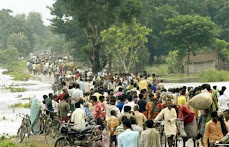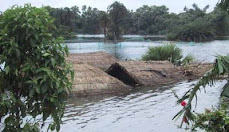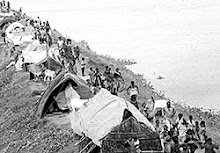Interaction on ‘The Kosi Breach and Beyond’
Living with the Kosi
At a meeting on - 17 December 2008 in Patna, experts from Nepal and India grapple with watery issues.
By Shiven Thapa
Thousands of years ago, hunter-gatherer societies discovered that hunting alone is insufficient for their long-term survival and they subsequently took to farming. In need of perennial sources of water for their crops, they moved to lands that were close to rivers. As much as the rivers became the lifeblood of these societies, the natural process of occasional flooding led human settlers to either ‘learn to live with the flow’ or ‘manage’ it.
Thus, began the epic struggle between these two divergent approaches, which ceaselessly continue to awe and shock humans till date – evident from the 18 August flooding of the plains of north Bihar and India, as the Kosi River breached its eastern embankment, and devastated lives and livelihoods, as it has done for more than one millennium. With this breach, the Kosi has carved out a new route altogether and there is a river now where there was earlier none. The Kosi has shifted 120 km eastwards, going back to a course it had abandoned more than 300 years ago and in so doing; it has rendered more than 300 km of embankments useless. On 27 August, the Prime Minister of India, Manmohan Singh declared the floods in Bihar a “national calamity”. The Kosi floods have left more than two million people homeless, and destroyed 250,000 homes, including 247,000 acres of farm land.
To take stock of this tragedy and encourage further debate on the issue, Barh Mukti Abhiyan and Himal Southasian organised a day-long conference in Patna on 17 December titled The Kosi Breach and Beyond. Water experts, engineers, activists, policymakers, researchers and journalists from India and Nepal participated in the meeting, and deliberated on the following issues of concern:
High dam vs. no dam
-There is a need to look at high dam proposals and the Kosi in the context of the broader India-Nepal water relationship.
-India is averse to Nepal receiving multilateral assistance on high dam projects.
-Where is the money and overall capacity for mammoth projects?
-If a high dam is built on the Kosi, massive displacement and submergence of areas will take place.
-Ethnic groups in Nepal are questioning the implications of a high dam on the proposed model of federal states.
-Large high-tech projects are the fantasies of ambitious rulers and do not rank on the cost-benefit scale.
-The 1950s was an era of engineers, the 1990s that of environmentalists, and in this decade, anthropologists also have a role to play – floods and dams cannot be confined to only engineering solutions.
-If a high dam is to be constructed upstream, three questions need to be answered – how much land will be submerged; is it earthquake-prone; and how much bio-diversity will be lost?
-Embankments are now being discredited in a coordinated way to build up a case for high dams on the Kosi.
-There is a contradiction between flood control and power generation – dams cannot be serving both purposes simultaneously.
-Multipurpose dams have limitations because of contradictory goals.
-The merits of the school of thought which says we should live with the floods, and advocates for a non-technological and non-interventionist solution.
Bureaucracy, policy and politics
-Bureaucratic red tape in India and Nepal – When the Kosi office in Biratnagar writes to the Ministry of Water Resources in Kathmandu, the complaint/query/suggestion is sent to the Ministry of Foreign Affairs. The Foreign Ministry then sends the note to the Ministry of External Affairs in New Delhi, which forwards it to the Bihar Government, which in turn dispatches it to the Kosi office located in Birpur.
-A parallel economy operates in the embankment areas due to the politician-contractor nexus. Until this is broken, innovative solutions to the annual Kosi crisis will be difficult to come by.
-There are major gaps between estimated and real areas irrigated. (see Dinesh Kumar Mishra’s table in Himal article.)
-National water policies of Nepal, Bihar and Uttar Pradesh appear to be similar.
-Government decisions are based on impulses – policymakers will never live to see the result of their decisions.
Solutions to the Kosi floods
-The best way out of the Kosi crisis is an integrated river basin approach.
-Social, environmental, economic costs must be measured – the Bhakra Nangal dam can be studied.
-Community centred, decentralised water management is needed – pick a tributary and be creative.
-Reductionist engineering interventions must be avoided.
-Lessons can be learnt from the Yellow River in China – they have built a dam that also generates 20,000 MW of electricity.
-Yearning for a permanent solution ignores the fact that engineering is simply a discipline of experiments.
Most issues raised during this interaction converged on the view that mainstream thinking on river management and engineering solutions have remained in a state of denial despite evidence to the contrary. The belief in embanking and damming remains as it was. The high dam proposals floating around in policy circles in India and Nepal claim to be a ‘permanent solution’, but overlook the dangers of seismicity. Moreover, water-related discussions in Southasia have often tended to focus on macro-level issues such as droughts, floods, rivers, dams, and irrigation, but without end-user involvement. There is also little evidence of intra-research community linkages, and no institutional mechanisms appear to be in place to share findings in a sustained manner. Studies on rivers in Southasia fail to take a comprehensive view of the river system – the river is often studied in isolation to the ecological system of which it forms an integral part. Clearly, the Kosi too cannot be understood in isolation.
WATCH OUT FOR EXTENSIVE REPORTAGE AND ANALYSIS IN HIMAL’S FEBRUARY 2009 ISSUE!
About the event:
Himal Southasian and Barh Mukti Abhiyan brought together 26 eminent water experts, engineers, activists, policymakers, researchers and journalists from India and Nepal for a day-long "Interaction on the 'Kosi Breach and Beyond'"
As the waters released by the 18 August breach of the eastern embankment above the Kosi Barrage at Kausaha in Nepal slowly recede, media coverage of the tragedy is fast dwindling both in Nepal and India. Given the impact of the Kosi inundation, which affects a large number people in one of Southasia’s poorest regions, and also due to the complicated geopolitical dimension of this cross-border river, it is important that a scientific, people-centered and humanitarian response be evolved.
One of the main focus of the event was the discussion on the impact of the recent breach, as also the viability of the different alternatives, including a) keeping the Kosi confined within the existing embankments; b) building a high dam; c) other possible engineering solutions; and d) going back to the historical experience of living with the flood in the plains, and adjusting livelihoods and infrastructure to the annual inundation.
Contact us at shiven@himalmag.com or at +977-1-5552141 for any queries regarding the event.
Programme:
Date: 17 December 2008
Venue: Hotel Ambassador, Patna, India
Welcome note: Dinesh Kumar Mishra
Introductory remarks: Kanak Mani Dixit
Session one:
Discussion on Kausaha Breach and status
Session two:
Status of proposed Kosi High Dam
Session three:
Consolidation of the proceedings for the day and open discussion
Participants list:
Ameet Dhakal
CK Lal
Dinesh Kumar Mishra
Dr Arun Dhoj Adhikary
Dr. V.N. Sharma
Devashish Chatterjee
Dunu Roy
Gopal Krishna
Hari Roka
Kalyan Rudra
Kanak Mani Dixit
Kavindra Pandey
Prashant Jha
Prof C.P. Sinha
Rajendra Dahal
Rajendra Singh
Sankar Ray
Tula Narayan Shah
Uday Shankar
Chandra Kishore Jha
Abhay Mohan Jha
Source: http://himalmag.com/The-Kosi-Breach-and-Beyond_dnw105.html
Historically, floods and their control have never been a big issue in the Ganga-Brahmaputra basin, as it is today. Floods became a major issue after the British occupied India. When they examined the Ganga basin, they believed that if it could be made “flood-free”, they could levy a tax in return for such protection.
Friday, 2 January 2009
Subscribe to:
Post Comments (Atom)








No comments:
Post a Comment